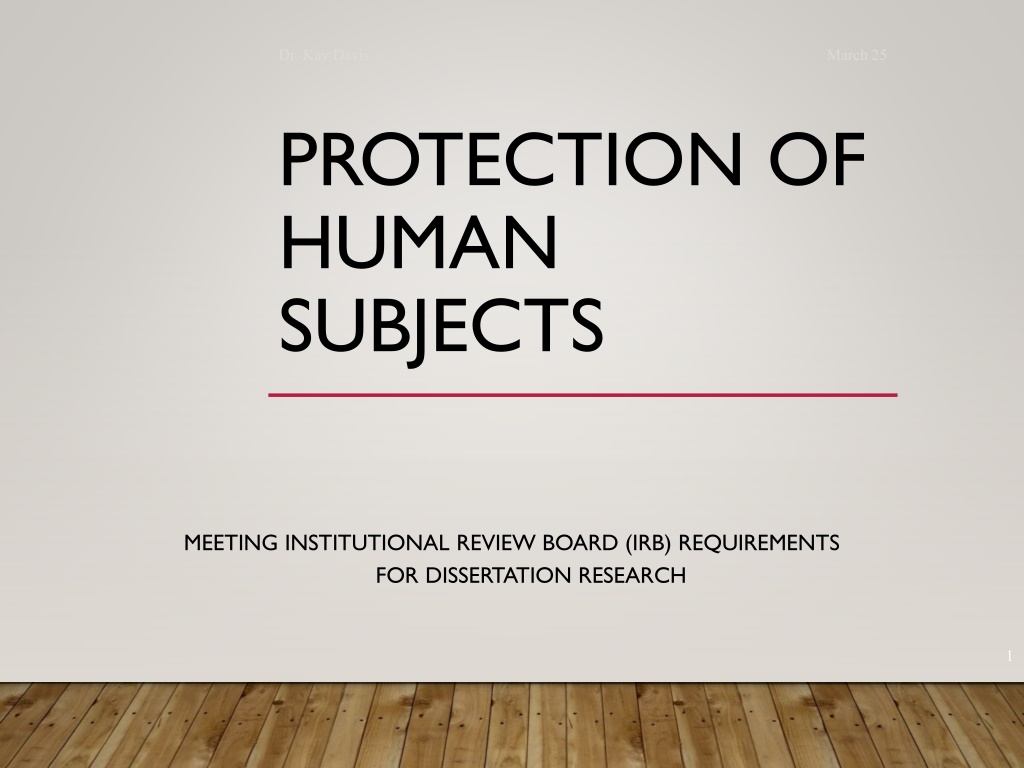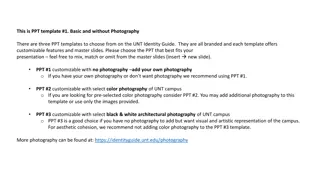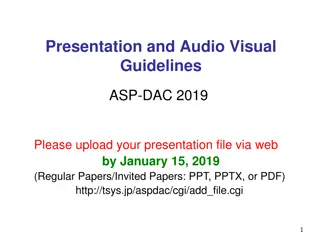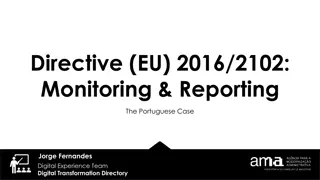
Meeting IRB Requirements for Dissertation Research with Dr. Kay Davis
Ensure compliance with ethical standards for research with human subjects, including protection of private information, risk assessment, and strategies for minimizing harm. Understand the definition of human subjects, risk levels, and methods for safeguarding participants in research activities.
Download Presentation

Please find below an Image/Link to download the presentation.
The content on the website is provided AS IS for your information and personal use only. It may not be sold, licensed, or shared on other websites without obtaining consent from the author. Download presentation by click this link. If you encounter any issues during the download, it is possible that the publisher has removed the file from their server.
E N D
Presentation Transcript
Dr. Kay Davis March 25 PROTECTION OF HUMAN SUBJECTS MEETING INSTITUTIONAL REVIEW BOARD (IRB) REQUIREMENTS FOR DISSERTATION RESEARCH 1
Dr. Kay Davis March 25 Ethical Standards for Research with Human Subjects 2 Decision for or against conducting the investigation Assuring freedom from coercion to participate Fairness and freedom from exploitation in the research relationship Confidentiality of the data and anonymity of the individual subject
DEFINITION OF HUMAN SUBJECT A human subject means a living individual about whom an investigator conducting research obtains data through an intervention with individual or identifiable private information 3 Dr. Kay Davis March 25
Dr. Kay Davis March 25 PRIVATE INFORMATION 4 Information about behavior that occurs in a context in which an individual can reasonably expect that no observation or recording is taking place Information which has been provided for specific purposes for which the individual can reasonably expect will not be made public .
Dr. Kay Davis March 25 A subject is considered at risk if they are exposed to the possibility of harm as a consequence of the research activity RISK 5 Physical, psychological, sociological, or other
Dr. Kay Davis March 25 MINIMAL RISK 6 Is when the anticipated risks of harm are not greater than those ordinarily encountered in daily-life or during the performance of routine physical or psychological examinations or tests
Dr. Kay Davis March 25 Screening out subjects who may be particularly susceptible to the risk Continuous monitoring of subject during data collection procedures MINIMIZING RISKS OF HARM 7 Minimizing the level and duration of the risk Use of measures to detect and correct any consequences of the risk Consulting with colleagues for techniques of minimization
Dr. Kay Davis March 25 Explanation of the purpose and duration of research activities Description of any reasonably foreseeable risks or discomforts INFORMED CONSENT 8 Description of any benefits which may reasonably expected A statement describing the extent, if any, to which confidentiality of records identifying the subject will be maintained Capturing subject signature is NOT a requirement
Anonymity when a person is not named or identifiable in any manner to the researcher ANONYMITY AND CONFIDENTIALITY Confidentiality when personally identifiable and private information is entrusted to an investigator to not disclose it.
Routine practices for assuring confidentiality substituting codes for identifying information; removing cover sheets (containing names and addresses); limiting access to identified data; storing research records in locked cabinets. CONFIDENTIALITY Signed consent forms are records that contain confidential information Alter Informed Consent Process: Provide IC though don t obtain signature if not needed
Describe procedures through which the security of the data will be maintained for both hard copies and electronic formats DATA SECURITY Security procedures include: Maintaining separation of subject identity from subject data Storing data securely for the minimum required time (3 years) though not keeping duplicate copies on multiple devices or recordings after data is transcribed. Delineation of the terms of data access and use, if data are going to be archived for use by you and/or other investigators in the future
Dr. Kay Davis March 25 An explanation as to whether any compensation is available as well as follow up care FOR RESEARCH INVOLVING MORE THAN MINIMAL RISK 12 An explanation of whom to contact for answers to pertinent questions about the research A statement that participation is voluntary, and refusal to participate will involve no penalty of loss of benefits to which the subject is otherwise entitled
Dr. Kay Davis March 25 Pregnant women In utero or ex utero fetuses Prisoners Vulnerable Human Subjects 13 Children Mental health patients
Dr. Kay Davis March 25 DIFFERENT CLASSIFICATIONS 14 Non human subject research Research with minimal risk which qualifies as Exempt Research Research with minimal risk and subject to Expedited Review Research requiring Full Review
Dr. Kay Davis March 25 NON-HUMAN SUBJECTS RESEARCH 15 Non-Human Subjects Research: Non-Human Subjects Research:If you believe your project does not constitute human subjects research, per Pepperdine University Institutional Review Board (IRB) guidelines and your dissertation chair s approval, review and complete the Non-Human Subjects Notification Form and submit to the IRB manager.
Full Review Requires review by the entire committee during scheduled meetings Expedited Review STANDARDS/CRITERIA FOR APPROVAL ARE IDENTICAL FOR EACH REVIEW PROCESS Two reviewers Exempt (from Full Review) One reviewer
Dr. Kay Davis March 25 EXEMPT RESEARCH 17 To qualify for review at the exempt level, the research must not be greater than minimal risk* and must fall into one or more of the exempt categories [45CFR 46.101(b)] There are 8 categories that qualify for exempt status Exempt review is not allowed if the study involves vulnerable populations, including children Survey research on children is not exempt Public observation of children is allowed if there is no participation by the researcher in the activities being observed
Dr. Kay Davis March 25 EXEMPT CATEGORY 1: EDUCATION RESEARCH 18 Research conducted in established or commonly accepted educational settings, involving normal educational practices, such as (i) research on regular and special education instructional strategies, or (ii) research on the effectiveness of or the comparison among instructional techniques, curricula, or classroom management methods.
Dr. Kay Davis March 25 includes the caveat that there must not be any impact of subject s opportunity to learn or any negative impact if the research involves an evaluation of the instructors. 19 EXEMPT CATEGORY 1: EDUCATION RESEARCH there must be protection against negative impact on employment if instructors are being evaluated.
Dr. Kay Davis March 25 Pregnant women may be included in this type of research.. Research that targets a prisoner population is not eligible for this exemption. The exemption is allowable if the research is aimed at a broader population and only incidentally includes prisoners. 20 CATEGORY 1: EDUCATION RESEARCH APPLICABILITY TO VULNERABLE POPULATIONS Research involving children is eligible for this exemption
Dr. Kay Davis March 25 EXEMPT CATEGORY 2: SURVEYS, INTERVIEWS, EDUCATIONAL TESTS, PUBLIC OBSERVATIONS 21 Research involving the use of educational tests (cognitive, diagnostic, aptitude, achievement), survey procedures, interview procedures or observation of public behavior, unless: information obtained is recorded in such a manner that human subjects can be identified, directly or through identifiers linked to the subjects; and any disclosure of the human subjects responses outside the research could reasonably place the subjects at risk of criminal or civil liability or be damaging to the subjects financial standing, employability, or reputation.
Dr. Kay Davis March 25 Category involves data collection interactions: verbal and written responses 22 EXEMPT CATEGORY 2: SURVEYS, INTERVIEWS, EDUCATIONAL TESTS, PUBLIC OBSERVATIONS The data collection can include audio or video recordings. Research involving interventions would not be approvable under this category. Interventions include manipulation of the environment or physical procedures to collection information, such as a cheek swab
Dr. Kay Davis March 25 Pregnant women may be included in this type of research 23 EXEMPT CATEGORY 2: SURVEYS, INTERVIEWS, EDUCATIONAL TESTS, PUBLIC OBSERVATIONS. APPLICABILITY TO VULNERABLE POPULATIONS Research that targets a prisoner population is not eligible for this exemption. The exemption is allowable if the research is aimed at a broader population and only incidentally includes prisoners. Research involving children is eligible for this exemption only when it related to educational tests or observations in which the investigators don t participate in the activities being observed.
Dr. Kay Davis March 25 CATEGORY 3: STUDIES OF PUBLIC OFFICIALS 24 Research involving the use of educational tests/ benign behavioral interventions (cognitive, diagnostic, aptitude, achievement), survey procedures, interview procedures, or observation of public behavior that is not exempt under paragraph (2) of this section, if: (i) the human subjects are elected or appointed public officials or candidates for public office; or (ii) Federal statute(s) require(s) without exception that the confidentiality of the personally identifiable information will be maintained throughout the research and thereafter.
25 Dr. Kay Davis March 25 CATEGORY 4: ANALYSIS OF PREVIOUSLY- COLLECTED, ANONYMOUS DATA Research involving the collection or study of existing data, documents, records, pathological specimens, or diagnostic specimens, if these sources are publicly available or if the information is recorded by the investigator in such a manner that subjects cannot be identified, directly or through identifiers linked to the subjects.
Dr. Kay Davis March 25 26 CATEGORY 5: PUBLIC BENEFIT OR SERVICE PROGRAM Research and demonstration projects which are conducted by or subject to the approval of department or agency heads, and which are designed to study, evaluate, or otherwise examine: (i) Public benefit or service programs; (ii) procedures for obtaining benefits or services under those programs; (iii) possible changes in or alternatives to those programs or procedures; or (iv) possible changes in methods or levels of payment for benefits or services under those programs
Dr. Kay Davis March 25 CATEGORY 6: CONSUMER ACCEPTANCE, TASTE, AND FOOD QUALITY STUDIES 27 Taste and food quality evaluation and consumer acceptance studies, (i) if wholesome foods without additives are consumed or (ii) if a food is consumed that contains a food ingredient at or below the level and for a use found to be safe, or agricultural chemical or environmental contaminant at or below the level found to be safe, by the Food and Drug Administration or approved by the Environmental Protection Agency or the Food Safety and Inspection Service of the U.S. Department of Agriculture
Dr. Kay Davis March 25 Pregnant women may be included in this type of research. Research that targets a prisoner population is not eligible for this exemption. The exemption is allowable if the research is aimed at a broader population and only incidentally includes prisoners. 28 CATEGORY 6: CONSUMER ACCEPTANCE, TASTE, AND FOOD QUALITY STUDIES APPLICABILITY TO VULNERABLE POPULATIONS Research involving children is eligible for this exemption. Research involving decisionally-impaired persons could be allowed if their inclusion was justified.
Dr. Kay Davis March 25 IMPORTANT NOTE ON CATEGORIES 7 & 8 INVOLVING BROAD CONSENT 29 Because there is no guidance from OHRP and because of the implications of tracking individuals who do not provide consent and excluding their data from all future research, Pepperdine will not mandate nor implement broad consent at this time. Exemption categories 7 and 8, which rely on Broad Consent will not be available in the Pepperdine eProtocol system. Investigators can continue to use biospecimens that are coded or to seek waiver of consent for use of biospecimens with identifiers retained consistent with current practices.
30 Dr. Kay Davis March 25 EXEMPT CATEGORIES 7 & 8 INVOLVING: SECONDARY RESEARCH REQUIRING BROAD CONSENT Category 7: Research involving the use of identifiable private information or identifiable biospecimens for secondary research use, if the following criteria are met: (i) Broad consent for the storage, maintenance, and secondary research use of the identifiable private information or identifiable biospecimens was obtained in accordance to IRB approval; (ii) Documentation of informed consent or waiver of documentation of consent was obtained.(iii) Category 8: Secondary research uses of identifiable private information or identifiable biospecimens, if at least one of the following criteria is met: The identifiable private information or identifiable biospecimens are publicly available; (ii) Information, which may include information about biospecimens, is recorded by the investigator in such a manner that the identity of the human subjects cannot readily be ascertained directly or through identifiers linked to the subjects, the investigator does not contact the subjects, and the investigator will not re-identify subjects; (iii)
Dr. Kay Davis March 25 Study design Investigator qualifications Selection of subjects WHAT ISSUES ARE CONSIDERED DURING AN IRB REVIEW? (45 CFR 46.111) 31 Risks Benefits Informed consent process Subject privacy/confidentiality Data confidentiality HIPPA applicability & procedures followed
Dr. Kay Davis March 25 Insufficient information provided and/or the specific application questions are not being answered Lack of detail about specific procedures to which participants will be exposed COMMON ERRORS IN IRB APPLICATION 32 What is the nature, timing, and sequencing of all proposed contacts with participants? Failure to allow sufficient time for review (e.g., submitting an application a week before you wish to begin data collection)
Dr. Kay Davis March 25 KEY TO SUCCESS 33 Understand Understand the guidelines Know Know the details of your proposed methods Anticipate Anticipate the possible risks to your subjects Use Use the required forms and procedures Plan Allow sufficient time for review process






















